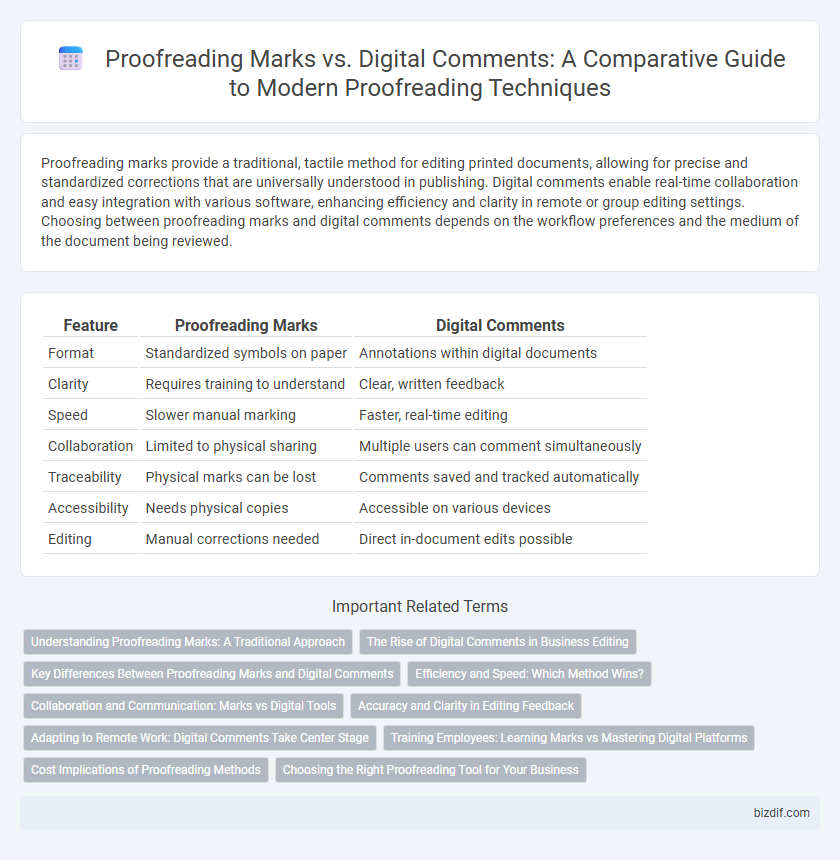Proofreading marks provide a traditional, tactile method for editing printed documents, allowing for precise and standardized corrections that are universally understood in publishing. Digital comments enable real-time collaboration and easy integration with various software, enhancing efficiency and clarity in remote or group editing settings. Choosing between proofreading marks and digital comments depends on the workflow preferences and the medium of the document being reviewed.
Table of Comparison
| Feature | Proofreading Marks | Digital Comments |
|---|---|---|
| Format | Standardized symbols on paper | Annotations within digital documents |
| Clarity | Requires training to understand | Clear, written feedback |
| Speed | Slower manual marking | Faster, real-time editing |
| Collaboration | Limited to physical sharing | Multiple users can comment simultaneously |
| Traceability | Physical marks can be lost | Comments saved and tracked automatically |
| Accessibility | Needs physical copies | Accessible on various devices |
| Editing | Manual corrections needed | Direct in-document edits possible |
Understanding Proofreading Marks: A Traditional Approach
Proofreading marks are standardized symbols used to indicate corrections in printed or handwritten documents, providing clear, concise instructions for editors and writers. These traditional marks facilitate precise identification of errors such as spelling, punctuation, grammar, and formatting issues, ensuring consistent communication across various proofreading contexts. Mastery of proofreading marks remains essential for professionals working with physical documents or preparing manuscripts for print publication.
The Rise of Digital Comments in Business Editing
Digital comments have revolutionized business editing by enabling precise, real-time collaboration and streamlining the revision process compared to traditional proofreading marks. Tools like Microsoft Word and Google Docs allow editors and clients to insert context-specific feedback directly within the text, enhancing clarity and reducing misinterpretations. The rise of digital comments supports efficient project management and faster turnaround times in professional editing workflows.
Key Differences Between Proofreading Marks and Digital Comments
Proofreading marks are traditional, handwritten symbols used to indicate corrections on printed documents, providing precise, standardized visual cues for editing tasks. Digital comments, by contrast, enable interactive feedback through electronic platforms, allowing users to insert, reply, and track changes dynamically within the text. The key differences lie in the medium, with proofreading marks offering tangible, direct annotations on paper, while digital comments facilitate collaborative, real-time communication in a virtual environment.
Efficiency and Speed: Which Method Wins?
Proofreading marks offer a tangible, visual method for identifying errors quickly on physical documents, enhancing speed when working with printed drafts. Digital comments streamline the editing process by allowing instant, collaborative feedback and easy tracking of changes, significantly boosting overall efficiency. For fast-paced projects requiring real-time cooperation, digital comments generally outperform traditional proofreading marks in speed and workflow integration.
Collaboration and Communication: Marks vs Digital Tools
Proofreading marks provide a tactile, visual way to communicate specific edits directly on printed documents, fostering clear, focused collaboration among editors and writers. Digital comments enable real-time interaction, seamless sharing, and integrated revision tracking within collaborative platforms, enhancing communication efficiency. Choosing between marks and digital tools depends on the workflow context, with digital comments excelling in remote teamwork and proofreading marks benefiting hands-on, in-person editing sessions.
Accuracy and Clarity in Editing Feedback
Proofreading marks provide precise, standardized symbols that ensure accuracy by clearly indicating specific errors and corrections, fostering unambiguous communication between editor and author. Digital comments offer flexibility with color-coding and detailed explanations, enhancing clarity by allowing contextual feedback directly adjacent to the text. Combining both methods maximizes editing precision and clarity, streamlining the revision process and reducing misunderstandings.
Adapting to Remote Work: Digital Comments Take Center Stage
Digital comments have become essential in remote work environments, offering real-time collaboration and seamless integration with editing platforms. Unlike traditional proofreading marks, digital tools enable precise tracking, instant feedback, and efficient version control, enhancing workflow productivity. Embracing digital comments ensures clear communication and faster turnaround times in geographically dispersed teams.
Training Employees: Learning Marks vs Mastering Digital Platforms
Training employees in proofreading requires a clear distinction between traditional proofreading marks and mastering digital commenting platforms, as each method demands different skill sets and cognitive approaches. Understanding and correctly applying standardized proofreading marks enhances accuracy in printed materials, while proficiency in digital comments enables efficient collaboration and real-time feedback in virtual environments. Investing in comprehensive training programs that cover both systems ensures employees can seamlessly transition between print and digital workflows, improving overall editorial quality and communication.
Cost Implications of Proofreading Methods
Proofreading marks require physical materials and manual labor, often increasing costs due to printing and shipment expenses. Digital comments reduce overhead by enabling instant, electronic feedback and collaboration, lowering overall project expenses. However, advanced digital proofreading tools may involve subscription fees, balancing cost-effectiveness with technological investment.
Choosing the Right Proofreading Tool for Your Business
Selecting the right proofreading tool for your business depends on balancing traditional proofreading marks with digital comments to optimize clarity and collaboration. Proofreading marks offer standardized, universally recognized symbols that streamline physical document editing, while digital comments enable real-time feedback, easy tracking, and efficient revision cycles in collaborative environments. Tailoring the choice to your team's workflow enhances accuracy, reduces turnaround time, and supports seamless integration with existing document management systems.
Proofreading Marks vs Digital Comments Infographic

 bizdif.com
bizdif.com